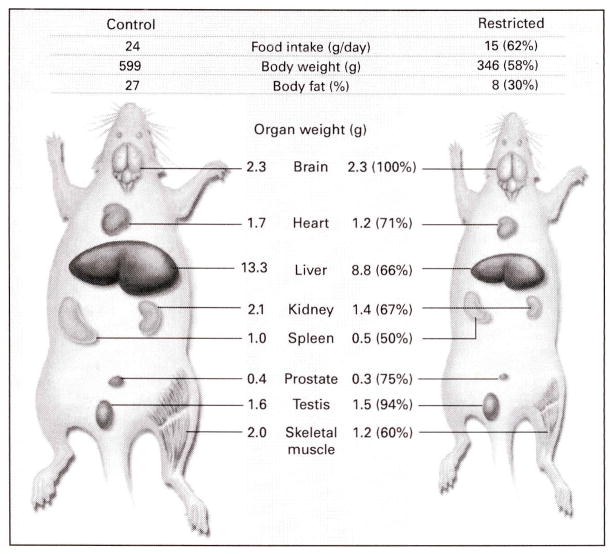From Brandhorst et al.(including Valter Longo), 2015 (1):
Mice were fed the FMD starting at 16 months of age for 4 days twice a month and were fed an ad lib diet in the period between FMD cycles. Mice on the control diet reached maximum weight (36.6 ± 5.2g) at 21.5 months of age whereas those in the FMD group lost ~15% weight during each FMD cycle but regained most of the weight upon re-feeding (Fig. S1 A).
However, FMD group mice maintained a similar weight between 16 and 22 months and then gradually lost weight (Fig. 1 D). Although FMD group mice were severely calorically restricted during the diet, they compensated for this restriction by overeating during the ad
lib period, resulting in a 14 day cumulative calorie intake equivalent for the FMD and the ad lib groups (Fig. 1 E and Fig. S1 B).
Note that mice on FMD develop an “eating disorder”: they overeat all the time during the phase when they are not calorie-restricted. Here is the last paragraph of the citation above, in case our reader missed it:
Although FMD group mice were severely calorically restricted during the diet, they compensated for this restriction by overeating during the ad lib period, resulting in a 14 day cumulative calorie intake equivalent for the FMD and the ad lib groups.
The “fast mimicking diet”, FMD, has quite an extreme impact on the organ size of mice. There is a considerable reduction in organ size. But in mice, organs return to the previous size after several days of refeeding. The same does not seem to apply to humans.

There is an informative picture of organ reduction in rats fed 50% of the normal ad libidum intake. It is from an article by Weindruch and Sohal, 1997 (2).

Data are from studies of 24-month-old male Sprague–Dawley rats either fed a control diet (80 percent of the average ad libitum intake) or subjected to caloric restriction (approximately 50 percent of the ad libitum intake) starting at 1 month of age. The numbers in parentheses are percentages of control values. The reduction in the weights of organs with caloric restriction varies widely. (Data kindly provided by Dr. Kevin Keenan, Merck, West Point, Pa.)
From Weindruch, Sohal, 1997.
The verdict:
The impact of a total intake of 1000 kCal a day during 5 days in humans has very little to do with the dramatic impact that 4 days of caloric restriction have on mice. The FMD mice would lose 15% of its body weight and over 30% of its liver weight every 2 weeks during a period of 3 months.
Does it mean that 5 days at 1000 kCal a day in humans is completely useless? Some positive impact is possible but the role of fasting and periodic caloric restriction in humans need to be understood better. This is one of the topics of our research at The New Neander’s Physiological Literacy.
Another important topic of our current research is the impact that chronic, and often unintended, caloric restriction may have on human organs, lean mass and behavior.
Selected References:
1. Brandhorst et al., Cell Metab. 2015 July 7; 22(1): 86–99.
2. Weindruch, Sohal, N Engl J Med. 1997 Oct 2; 337(14): 986–994.

1 Comment